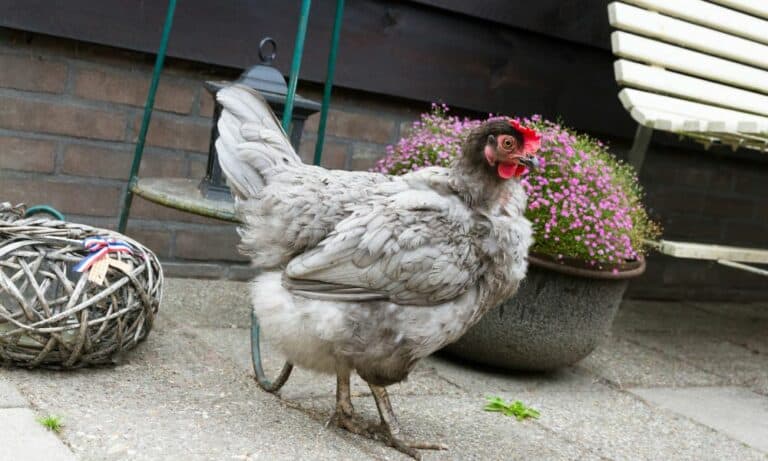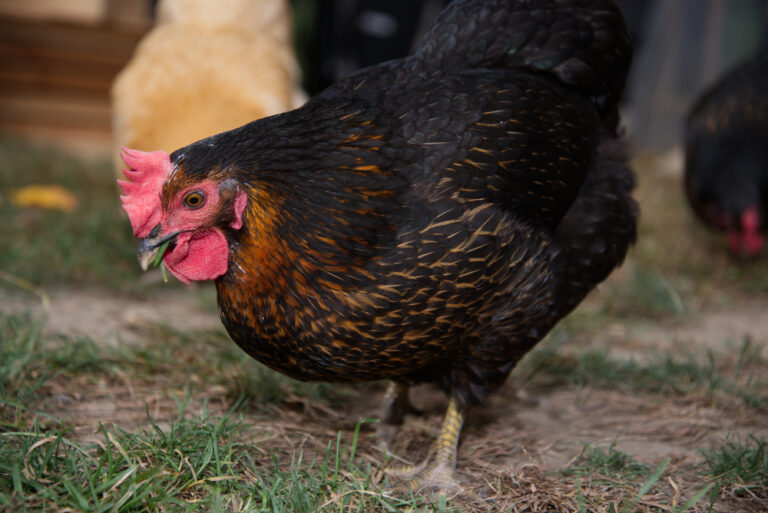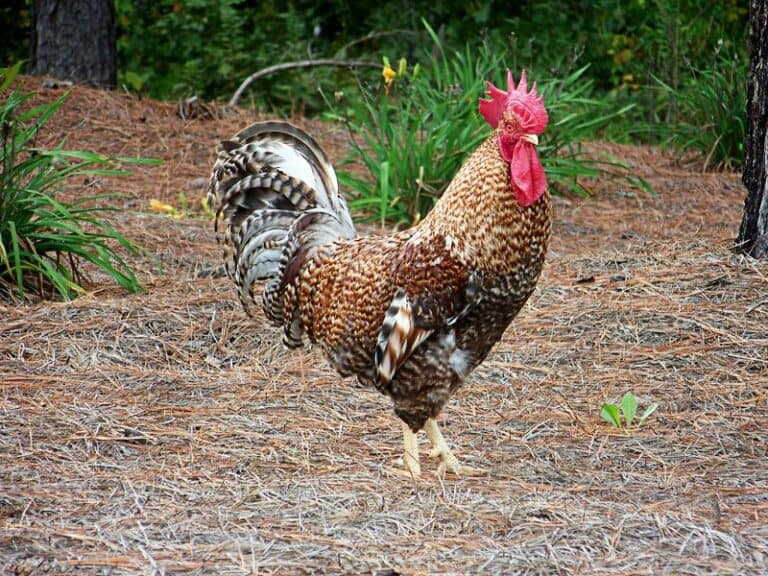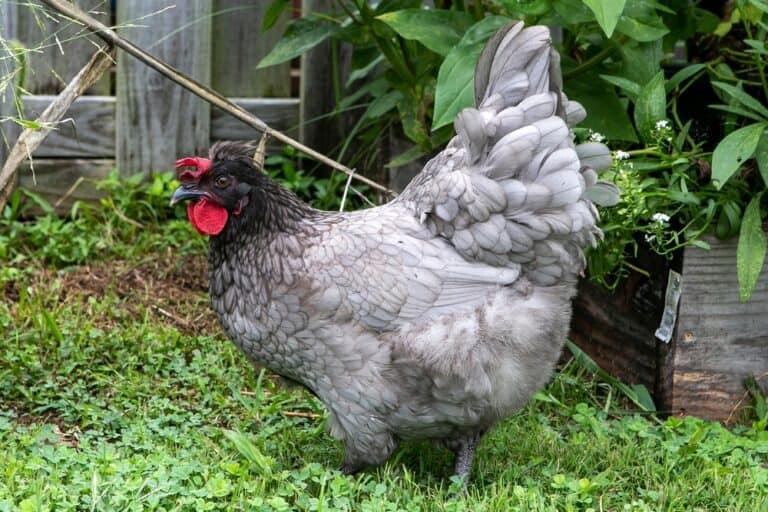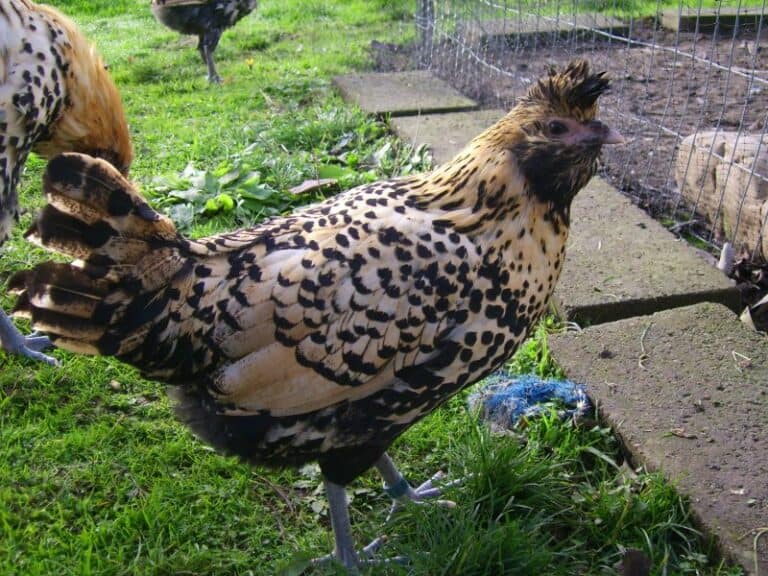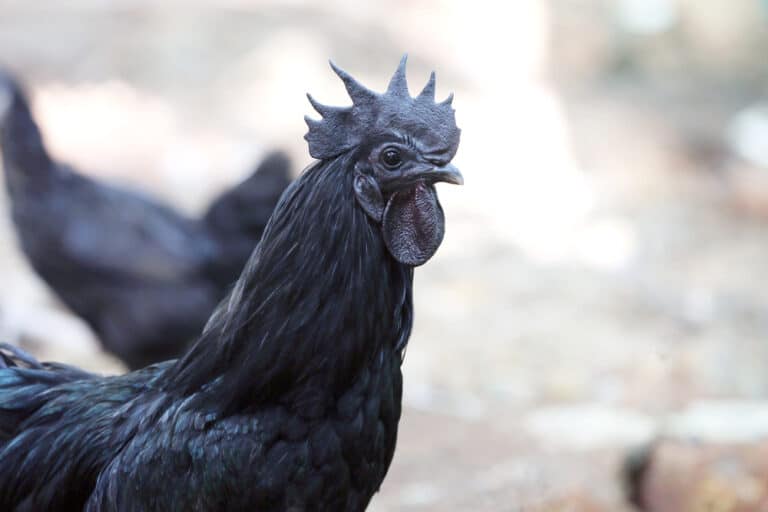Langshan chickens (Wolf Hill, Wolf Mountain) are ornamental chickens native to China you can breed for eggs and meat. They appeared in England in 1872 when English Major A.C. Croad imported them for the first time in Europe. Six years later, the new breed was exported to the US in 1878.
Because of misunderstanding, farmers bred them with Cochins so that you can recognize four distinct types nowadays. The most popular is black Croad Langshan, recognized by the APA Standard of Perfection. Besides, you can find white and cross-bread blue varieties.
Langshan chicken |
|
| Origin | China |
| Category | Ornamental |
| Breed size | Large |
| Broodiness | Moderate |
| Rarity | Rare to threatened |
| Varieties | Croad Langshan, Deutchman (German Langshan), Australian Langshan, and Modern Langshan |
| Climate tolerance | Moderate to excellent tolerance to heat and cold |
| Care level | Easy-to-care |
| Lifespan | 5 to 10 years |
| Height | 26 to 30 inches (66 – 76 cm) |
| Standard weight | Cock – 7.5 to 9.5 pounds (3.4 – 4.3 kg)Hen – 5.5 to 7.5 pounds (2.5 – 3.4 kg) |
| Australian Bantam weight | Cock – 2 pounds (0.9 kg)Hen – 1.65 pounds (0.75 kg) |
| Feather color | Black, blue, and white |
| Skin color | White |
| Comb type | Single |
| Beak color | Bluish or dark horn with pinkish-white tip, depending on a type |
| Leg color | Blue or black |
| Leg type | With moderate or without feathering, depending on a type |
| Purpose | Dual purpose, for eggs and meat |
| Egg size | Large |
| Egg color | Brown, sometimes with a purplish hue |
| Annual egg production | 160 to 240 |
| Sitter | Moderately to excellent broody |
| Flying ability | Can, but roosters never fly |
| Temperament | Docile, friendly, tolerant, tame, calm |
| Aggression toward flock members | Low |
| Beginner friendly | Yes |
| Achieving full size | 20 to 22 weeks |
| Start of egg production | 5 to 7 months |
| Beginning of the meat harvest | 4 to 6 months |
| Noise level | Moderate |
| Toleration to confinement | Good |
| Foraging ability | Good |
| Predator evasion | Excellent |
| Price | $3.5 to $6.5 |
Langshan History
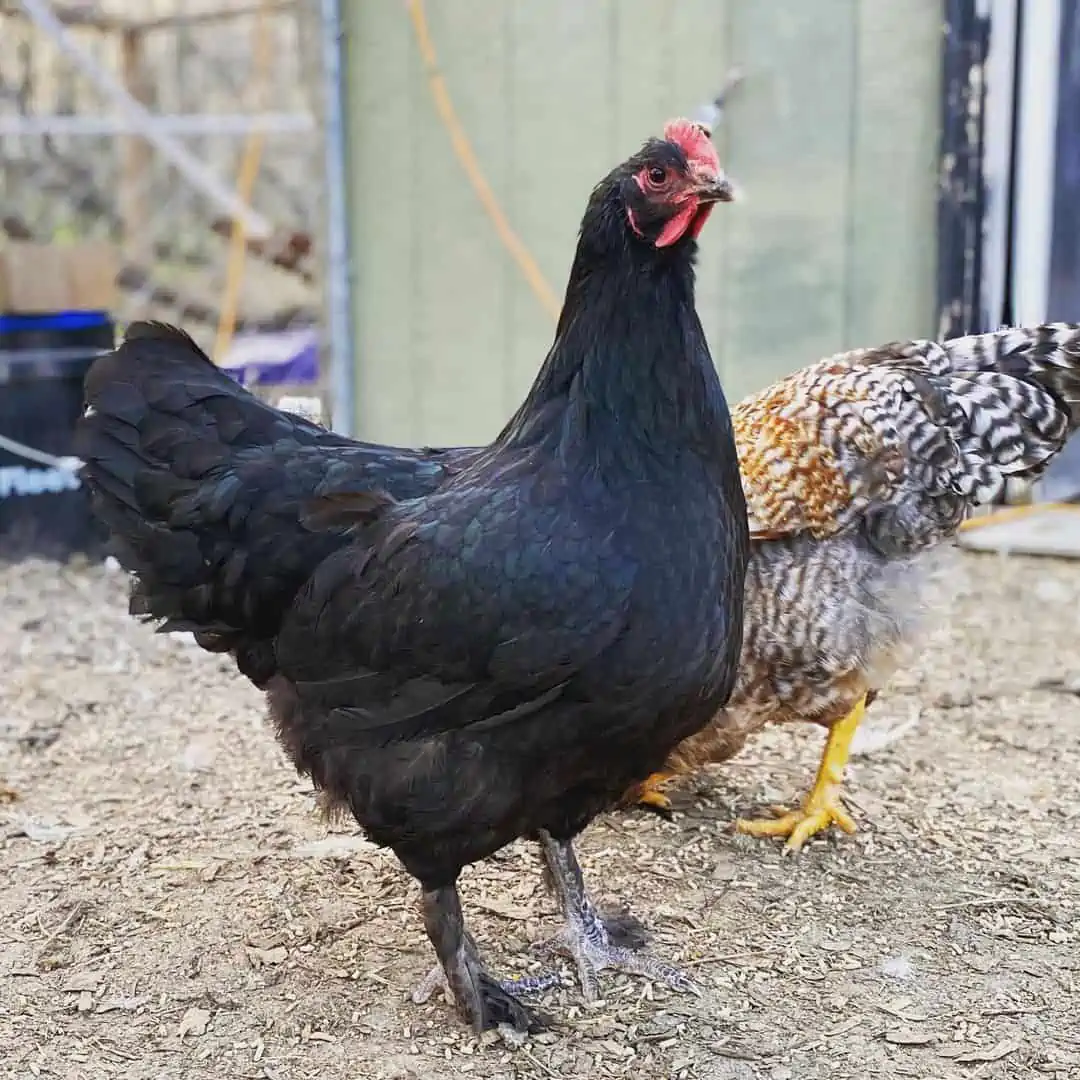
The Langshan chicken breed originated in China and probably got named after Langshan Hill, nearby the Yangtze River. The name means Wolf Hill and refers to a tourist attraction, thanks to a temple at the top.
No one knows precisely the exact origins of these beautiful birds. However, experts believe they were descendants of Silkie chickens, the ancient Chinese breed. That was one of the reasons why the Chinese government started a program of breed preservation in 1959.
In 1872, Major Croad imported the first flock to England, and the new breed quickly found its way to the US. Despite persistent opposition from reputable English breeders, his niece gave her best to establish these chickens.
As soon as ornithologist Samuels from Massachusetts brought these chickens to the New World in 1876, they became an attraction. Farmers liked a new breed because of its beauty, delicious meat, and decent number of eggs produced annually.
Nowadays, these chickens are not a common breed in the US. Thanks to a few major hatcheries that started breeding Langshans recently, enthusiasts and farmers can buy their chicks again.
Langshan Chicken Traits
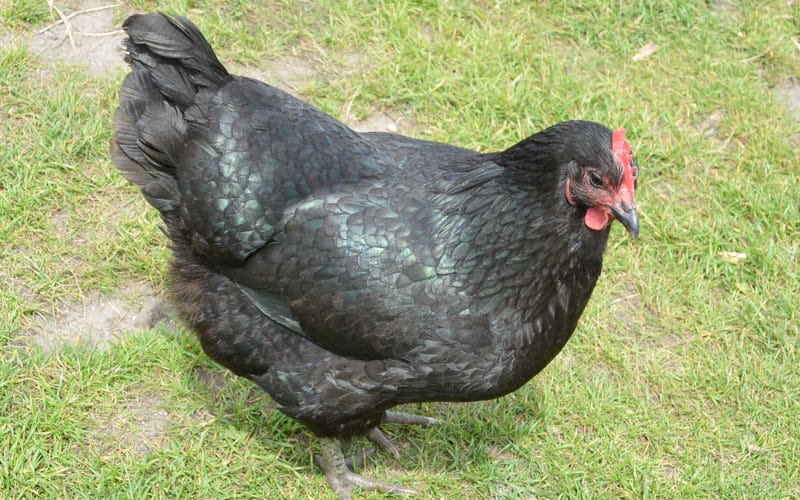
Nowadays, it is possible to differentiate four versions of this breed, including:
Croad (original) Langshan – It is considered an original breed and is the most common in the US and China. It got the name after Major Croad, who imported chickens from Asia to Britain.
The first flock was imported to the US in 1878. American breeders used these chickens to create Jersey Giant, one of the most popular American chicken breeds.
Nowadays, you can recognize original Croad (large) and bantam Langshan chicken types in black, white, and blue varieties. The Poultry Club of Great Britain and the American Poultry Association recognize all six.
Black Langshan was first recognized in 1883, and admirers formed the American Langshan Club four years later. It was followed by a white variety recognized in 1893 and finally a blue cross-breed in 1987.
Short-legged Langshan – These chickens were bred based on Cochins look. Breeders also used them to develop Orpington and black Cochin chickens.
Modern Langshan – This variety became common in the UK after English breeders developed taller chickens with smaller breasts, tighter plumage, and long legs without feathers.
German (Deutchman) Langshan – German breeders bred this variety primarily focused on prolific egg-laying. Chickens have smaller breasts and long, non-feathered legs.
You can also find the Australian Langshan chicken variety common in Australia. It is still not officially accepted by relevant international organizations, although this variety has been bred from the original chickens imported in 1905 from China. Nowadays, you can find them at exhibitions more often than on farms.
Breeders liked Langshan chickens from the start and often took advantage of their excellent traits to create new breeds. For instance, they were a base for creating Black Orpington, Barnevelder, and Maran chickens.
General Characteristics
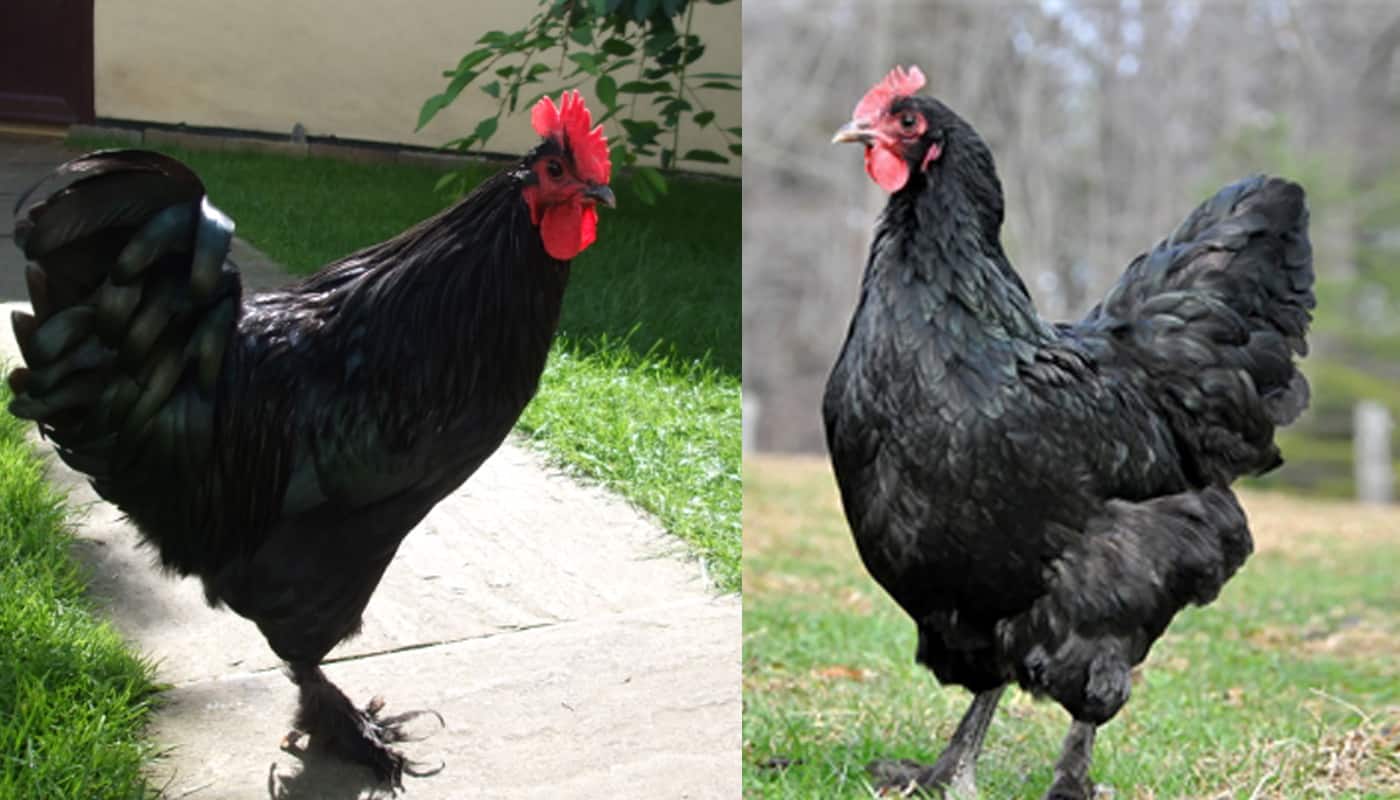
There are several Langshan chicken types, plus a bantam variety, and all have slightly different characteristics. Still, you can quickly recognize this breed after its unique look and behavior.
Appearance
These tall chickens have impressive red single combs standing upright and long, moderately feathered legs. Roosters’ high-up tails are up to 17 inches (43 cm) long and reach almost the same height as their heads.
Hens have shorter tails with less plumage and often come without feathers on their legs. Interestingly, this breed has smaller heads than others regard to their sizable bodies.
You can quickly recognize Langshan chickens thanks to their U-shaped bodies, compact plumage, and dark beaks with light tips. Their massive bodies and deep breasts make them an excellent meat breed.
Height and weight
Langshans are a large chicken breed with roosters weighing 7.5 to 9.5 pounds (3.4 – 4.3 kg). Hens are slightly smaller, with an average weight of 5.5 to 7.5 pounds (2.5 – 3.4 kg).
With a height of approximately 26 to 30 inches (66 – 76 cm), Langshans are in a group of the tallest non-game chicken breeds currently used for commercial purposes.
When you keep these large birds in free range, you should provide 3 to 4 sq ft (0.28 – 0.37 m2) per laying hen in a coop. Besides, they need at least 25 sq ft (2.3 m2) in a chicken run.
Bantam chickens are significantly smaller, with roosters reaching a modest 2 pounds (0.9 kg). Hens typically weigh only 1.65 pounds (0.75 kg).
Color
The original Langshan chickens have white skin covered by black feathers with a green sheen. However, you can also find varieties with white and blue plumage.
Behavior
Langshan chickens are docile, adaptable, and friendly. Therefore, some admirers consider them excellent pets and even lap chickens. They get along well with children, pets, and other animals in the same household. Even roosters are calm and gentle toward kids, particularly when they grow up together.
Purpose
Langshan chickens are a dual-purpose breed, and you can expect approximately 160 to 240 eggs a year besides delicious meat. Their meat is white with flavorful skin.
Brown eggs are medium to large, but be careful when buying chicks to prevent disappointments. Namely, the variety intended for exhibitions lays fewer eggs.
Hens begin with egg production once they are 5 to 7 months old and are seasonally broody. You can expect them to lay approximately four eggs with low cholesterol levels weekly. Their beautiful feathers are also useful and used for fly-fishing and millinery.
Be prepared that these sizable birds grow slowly and have a higher feed conversion ratio than other similar meat breeds. In other words, they require more food for the same amount of meat. You can expect them to be prepared for slaughter about 4 to 6 months after purchasing chicks.
Health Issues
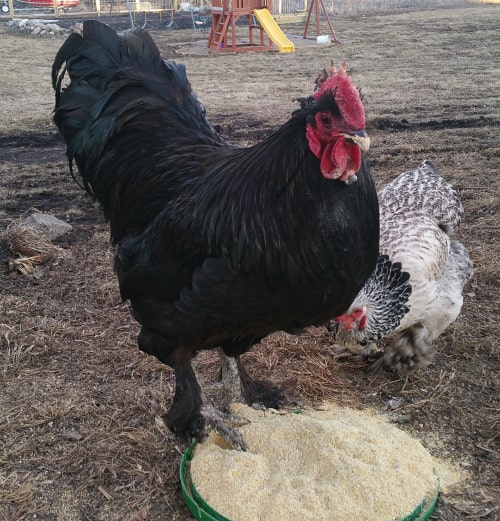
Langshans are quite active chickens that live 5 to 10 years on average. Unfortunately, this hardy breed is prone to several health issues, particularly when kept in inadequately small coops. Be prepared that your flock is at risk of suffering from conditions like:
Bumblefoot – This non-contagious bacterial infection causes feet swelling and redness, often leading to arthritis and lameness.
Prolapse (egg binding) – It appears when an egg gets stuck inside the hen’s oviduct. The condition is potentially deadly if you fail to notice the problem and bring your chicken to the vet to remove the egg within 48 hours.
Marek’s disease – This contagious viral poultry infection caused by a chicken herpes virus is non-curable. However, timely vaccination increases chickens’ chances of surviving the disease. It sometimes leads to tumors in the eyes and internal organs.
Fowl cholera – This chronic disease primarily affects Langshans’ joints and the sinuses, followed by diarrhea and swollen combs and wattles. Sometimes, the infection causes sudden deaths in chickens.
Newcastle disease – Since it is an acute respiratory disease, you can expect it to spread rapidly and kill the entire flock in several days.
Fowl pox – This contagious infection appears in Langshan chicks, causing distinctive wart-looked bumps on combs and wattles. It creates significant problems for owners because of chickens’ stunted growth.
Summary
Langshan chickens are a Chinese dual-purpose breed well-known for typical black feathers. These beautiful and elegant fowl lay large eggs and have delicious meat. The best of all is that they don’t require special care or particular condition to thrive. Since these ornamental birds are docile and friendly, you can keep them as pets.

